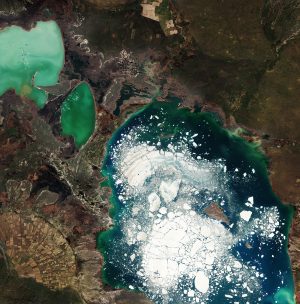
Large chunks of broken ice float in east-central Kazakhstan's Alakol Lake. (Credit: Contains modified Copernicus Sentinel data (2016), processed by ESA)
Kazakhstan's Alakol Lake typically freezes for about two months at the end of winter and breaks up in early spring, beautifully captured in this European Space Agency Sentinel-2 image. The salt lake's mineral-rich water and mud is considered therapeutic, and tourists often visit the lake's northern shores to remedy skin ailments.
The image's varying shades of green and blue depend on water depth, sediments flowing in from rivers and streams, and phytoplankton. The two smaller, shallower lakes to the northwest are Kosharkol and Sasykkol.
The Alakol-Sasykkol lake system is a Ramsar Wetland of International Importance, a UNESCO Biosphere Reserve, and an important migratory stop and nesting area for a variety of water birds, including the Dalmatian Pelican and Greater Flamingo.
Agricultural structures can be seen in an alluvial fan in the image's lower-left corner. The triangular fan forms when water runoff from the Dzungarian Alatau mountains (not pictured) hits the plain and spreads out, leaving behind fertile soil.

